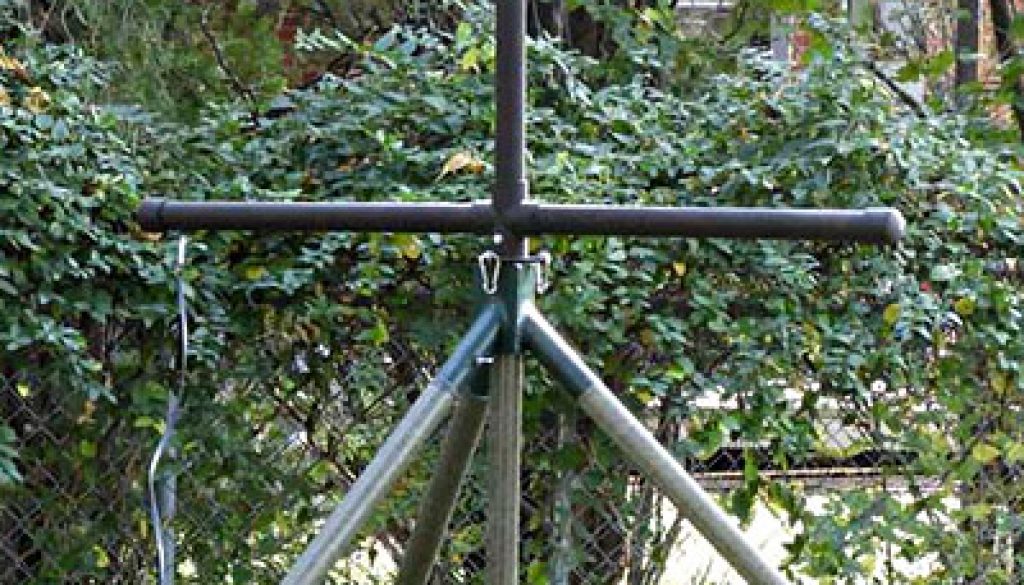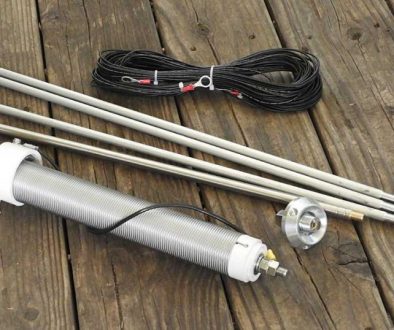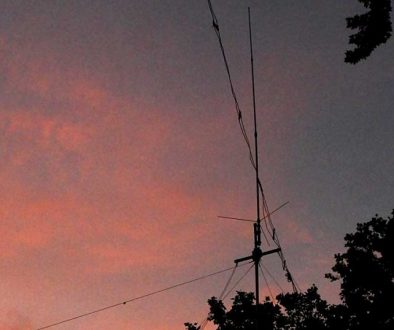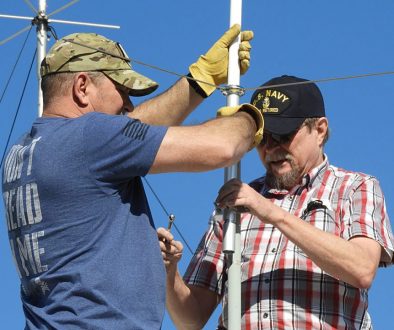Portable Fiberglass Antenna Mast
 I found what I believe to be a great solution for a portable antenna mast that can be used for EmComm purposes, field day, or even a temporary antenna deployment at home.
I found what I believe to be a great solution for a portable antenna mast that can be used for EmComm purposes, field day, or even a temporary antenna deployment at home.
I picked up this combo from BJB Farms at a recent ham fest in Wichita. This military fiberglass antenna mast is made up with 48″ surplus military fiberglass camo netting poles and a special tripod adapter for connecting it all together. This combo I purchased included poles for getting an antenna 32 ft. high, all stored inside a military carrying bag.
Components of Portable Fiberglass Antenna Mast
The tripod base for this portable antenna mast is made from fiberglass poles and a tripod adapter. I can use 3 legs for a simple tripod base and top-load the fiberglass poles or double stack 6 poles to raise the center point of the tripod higher and bottom feed the fiberglass poles. When bottom feeding, you will need poles that have the reinforced fiberglass collars that come with many fiberglass poles removed to fit inside the middle of the tripod. The tripod can then be tied down or strapped down using stakes. When using on pavement it can be weighed down using weights or sand bags.
 In addition, I can use the guy plates placed between any of the 4 ft. section of poles. I plan to guy it at the 16 ft. and 32 ft. levels. Also, there is a base stand at the bottom of the center pole section that can be anchored with stakes or weights to keep the tower stable and straight.
In addition, I can use the guy plates placed between any of the 4 ft. section of poles. I plan to guy it at the 16 ft. and 32 ft. levels. Also, there is a base stand at the bottom of the center pole section that can be anchored with stakes or weights to keep the tower stable and straight.
At the heart of this setup is the tripod that allows you to lock the legs so they don’t fall out while setting up. The inside diameter for the middle of the tripod is 1.8 inches; the legs are 1-3/4 inches to fit military fiberglass and aluminum poles only. If your poles have a ring on the bottom of it you will first need to cut the ring off in order to get the pole into the tripod and/or base. The tripod weighs almost 5 lbs.
 I fashioned a top section for the mast out of PVC to hang either an HF wire antenna or my 2 meter roll-up j-pole. There is also a vertical section that will allow me to attach a vertical antenna.
I fashioned a top section for the mast out of PVC to hang either an HF wire antenna or my 2 meter roll-up j-pole. There is also a vertical section that will allow me to attach a vertical antenna.
The assembly is made up of 3 sections of 1 1/2″ PVC connected at the center with a 4-way adapter that neatly slips on the male end of the fiberglass pole. To secure the top section to the center pole and keep it from moving around in the wind, I inserted a bolt with wing nut through the 4-way adapter and top section of pole. At the two ends of the horizontal sections I put eye hooks to suspend my antennas. I also put on the ends of the PVC pipe end caps to keep the moisture out of the inside of the poles and finished it off by painting the assembly a non-reflective camouflage color.
Setting up portable antenna mast
Set up and tear down takes only a few minutes and everything fits inside the carry bag making this antenna mast portable and simple to deploy.
It’s simple enough for one person to put up a 16′ mast. But, pushing it up vertically gets pretty heavy and the top of the mast gets pretty wonky above the 24′-28′ level. If you’re thinking of putting the sections together and walking it up, that’s probably NOT a good idea for anything higher than 16 or 20 feet. It’s possible to damage the joints if to much bending motion is put on the fiberglass joints and they can split.
Instead, attach guy ropes to the top section and ground anchors. Then, stand up the first three or four sections and let the mast lean against 2 of the guys to hold it up. Then pick the mast up vertically while keeping it leaning against the guy ropes and slip the next section in underneath. Set it back down while you grab the next section. Having assistants holding the guys to keep them tensioned while raising can be helpful, but with practice one person can do it.
The one down-side I see with this tripod antenna mast is that it needs to be deployed on level ground. I am investigating a method to shim up one or two legs of the base to allow for a level placement on uneven ground. Also, I’m looking into a method to attach spikes or something to attach to the ends of the three legs to even better secure the mast to the ground.




January 13, 2021 @ 6:53 am
Hi Vic,
The two issues that you want to resolve have easy fixes. I’ve done this with mine and it really functions perfectly.
Leveling: Cut three lengths of schedule 80 PVC (OD of the PVC to match the ID of the support legs) the length of the support legs. Drill and tap each support leg ¼”x 20 about 1½” from ground contact end of the support. Use ¼” x 20 x1″ bolts.
Securing: This is a little bit of a challenge because it requires you to drill the PVC at an angle that matches the angle of the support legs, mine was 30°. You will need to do the math as to the location of the holes. Drill a 9/16″ through each section of PVC. use 3 tie wall spikes to pass through the holes once the base has been assembled.
Hope to catch you on the air.
73!
KJ4JOA